In an era where social media has become a ubiquitous aspect of daily life, understanding the intricate web of global social media privacy laws has never been more crucial. This comprehensive analysis aims to unravel the complexities of these laws, offering a clear picture of how different regions approach the privacy and data protection of their digital citizens.
Introduction to Global Social Media Privacy Laws
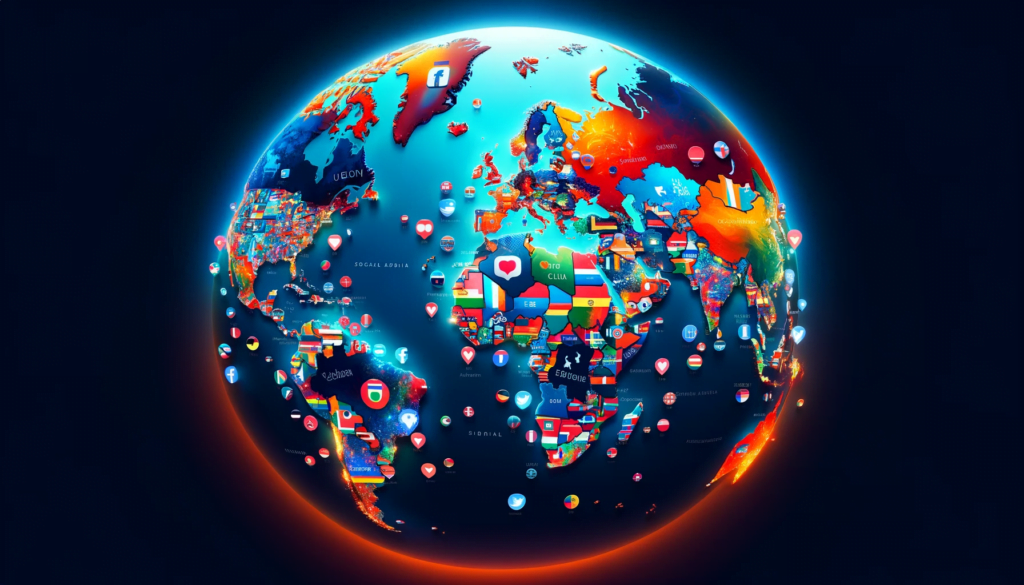
In our interconnected world, social media platforms connect millions of users across the globe, transcending borders and cultures. However, this digital unification brings forth significant challenges in privacy and data protection. Social media privacy laws, therefore, play a pivotal role in safeguarding user data against misuse and breaches.
These laws vary significantly from one country to another, reflecting diverse cultural norms, legal frameworks, and political environments. Understanding these differences is not just important for users but also for multinational companies that operate across these varied legal landscapes.
Understanding Social Media Privacy Laws
What Are Social Media Privacy Laws?
At their core, social media privacy laws are legal frameworks designed to protect individuals’ personal information on social media platforms. These laws regulate how companies can collect, use, store, and share user data. In essence, they are the guardians of our digital personas, ensuring that our online footprint remains secure and private.
The Importance of These Laws
- User Trust: Strong privacy laws build user trust in social media platforms.
- Data Protection: They ensure sensitive personal information is safeguarded.
- Legal Compliance: Companies are held accountable for their data practices.
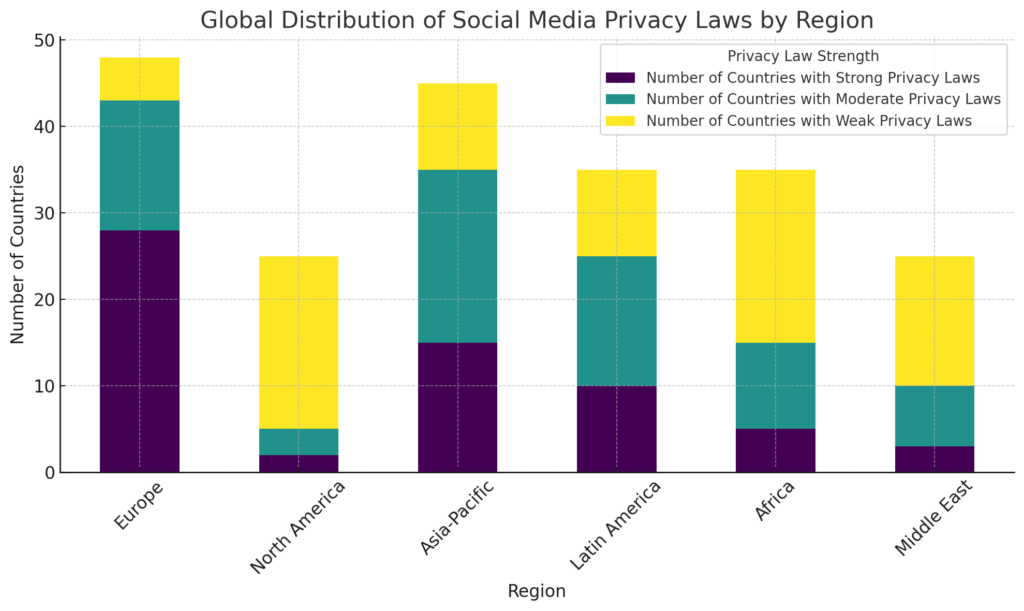
Table: Key Components of Social Media Privacy Laws
| Component | Description |
|---|---|
| Consent | Users must consent to their data being collected. |
| Data Minimization | Collect only necessary data. |
| Transparency | Clear policies on data usage. |
| User Control | Users can view, edit, or delete their data. |
| Data Security | Strong measures to protect data from breaches. |
Global Overview of Social Media Privacy Laws

The landscape of social media privacy laws around the world is both complex and diverse, reflecting a wide range of approaches based on cultural, legal, and political factors. Here’s an expanded overview of how different regions and key countries are shaping these laws:
1. European Union: GDPR as a Benchmark
- General Data Protection Regulation (GDPR): Introduced in 2018, GDPR has become a global standard, emphasizing user consent, data subject rights, and significant penalties for non-compliance.
- Influence on Global Practices: GDPR has influenced numerous countries outside the EU to revise their privacy frameworks.
2. United States: A Patchwork of State Laws
- No Federal Standard: The U.S. lacks a comprehensive federal data privacy law, but sector-specific laws like HIPAA (Health Insurance Portability and Accountability Act) play a role.
- State-Level Laws: California’s Consumer Privacy Act (CCPA) and similar laws in other states like New York and Virginia represent significant steps in data privacy at the state level.
3. Asia-Pacific: A Range of Approaches
- China: Characterized by strong state control, China’s Cybersecurity Law and Personal Information Protection Law (PIPL) focus on data security and control, along with user privacy.
- India: The proposed Personal Data Protection Bill emphasizes user consent, data localization, and the establishment of a Data Protection Authority.
- Australia and Japan: Both countries have established laws (Privacy Act in Australia, APPI in Japan) that regulate the use and handling of personal data.
4. Latin America: Rapidly Evolving Landscape
- Brazil’s LGPD: Brazil’s General Data Protection Law is similar to GDPR, representing a major step forward in privacy legislation in Latin America.
- Other Nations: Countries like Argentina, Chile, and Mexico have also been updating their privacy laws, showing a regional trend toward stronger privacy regulations.
5. Africa: Emerging Privacy Frameworks
- South Africa’s POPIA: The Protection of Personal Information Act is a comprehensive law that includes both protection of personal information and provisions for processing personal data.
- Other African Countries: Many are in the early stages of developing or implementing privacy laws, with varying degrees of comprehensiveness.
6. Middle East: Balancing Privacy and Control
- Diverse Approaches: Countries in the Middle East have varying approaches, with nations like the UAE implementing more comprehensive laws.
- Emphasis on Data Localization: Many laws in this region include provisions for data localization and control.
7. Canada: Balancing Business and Privacy
- PIPEDA: The Personal Information Protection and Electronic Documents Act governs the collection, use, and disclosure of personal data in a way that balances individual privacy rights with the needs of businesses.
Key Trends and Developments
- Global Data Protection Trends: There’s a growing global trend towards enhancing data protection and privacy, influenced heavily by the GDPR.
- Technological Impact: The rise of AI, IoT, and big data analytics is pushing for continuous updates and adaptations in privacy laws.
- User Empowerment: Across the globe, there’s a noticeable shift towards giving users more control and rights over their data.
Comparative Analysis by Regions

The global landscape of social media privacy laws varies significantly across different regions. Each region’s approach to data privacy reflects its cultural, legal, and political contexts. Here’s a detailed comparative analysis:
Europe: Pioneering Comprehensive Data Protection
- GDPR: The European Union’s General Data Protection Regulation (GDPR) is the cornerstone of data privacy laws, emphasizing user consent, data minimization, and significant fines for non-compliance.
- E-Privacy Directive: Complementing the GDPR, focusing on the confidentiality of electronic communications.
- Impact on Global Standards: GDPR has set a high benchmark globally, influencing privacy laws in various countries outside Europe.
North America: A Mixed Landscape
- United States: The U.S. has a sectoral approach with no overarching federal privacy law, but notable laws include the California Consumer Privacy Act (CCPA) and others at the state level.
- Canada: The Personal Information Protection and Electronic Documents Act (PIPEDA) governs data privacy, balancing user protection with business needs.
- Diverse State Laws: Variability in state laws within the U.S. creates a complex compliance environment for companies.
Asia-Pacific: Diverse Approaches
| Country | Privacy Law Overview |
|---|---|
| China | Strong state control with strict regulations. |
| India | Balancing privacy with digital growth. |
| Australia | Comprehensive privacy protections. |
- China: The Cybersecurity Law and the Personal Information Protection Law (PIPL) focus on data security and user consent but also emphasize state interests.
- India: The proposed Personal Data Protection Bill highlights user consent, data localization, and the establishment of a Data Protection Authority.
- Australia: The Privacy Act includes principles that govern the collection, use, and disclosure of personal information.
- Japan: The Act on the Protection of Personal Information (APPI) regulates the use of personal data.
Latin America: Emerging Privacy Frameworks
- Brazil: The General Data Protection Law (LGPD) mirrors GDPR in many aspects, marking a significant shift in privacy legislation in Latin America.
- Other Countries: Nations like Argentina and Chile have also updated their privacy laws, reflecting a growing trend towards stronger data protection across the region.
Africa: Developing Data Protection Laws
- South Africa: The Protection of Personal Information Act (POPIA) is a comprehensive privacy law, emphasizing accountability and user rights.
- Other Nations: Many African countries are in the early stages of developing or implementing data protection laws, with varying degrees of comprehensiveness and enforcement.
Middle East: Balancing Privacy with State Interests
- Varied Approaches: Countries in the Middle East have differing approaches to privacy, with some like the UAE implementing fairly comprehensive laws, while others have more nascent frameworks.
- Data Sovereignty: A common theme is the emphasis on data localization and sovereignty.
Key Regional Differences
- Compliance Challenges: Multinational companies face challenges in complying with the diverse regulations across these regions.
- Cultural and Political Influences: The cultural and political milieu of each region plays a significant role in shaping its privacy laws, from user-centric EU laws to state-centric laws in some Asian and Middle Eastern countries.
Key Differences and Similarities
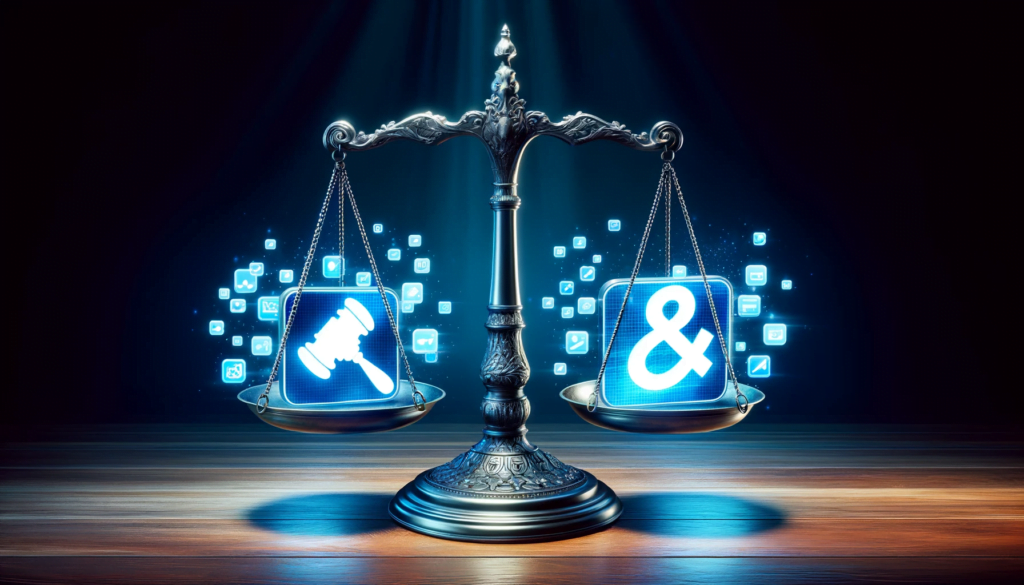
The landscape of global social media privacy laws is characterized by a mix of convergences and divergences. Understanding these similarities and differences is crucial for users, companies, and policymakers navigating the complex digital world.
Key Similarities
- Consent for Data Collection
- Across most regions, obtaining user consent for data collection is a fundamental requirement.
- Laws emphasize transparent and voluntary consent, though the specifics of obtaining it can vary.
- Right to Access and Rectification
- Many privacy laws grant individuals the right to access their data and correct inaccuracies.
- This empowers users to have more control over their personal information.
- Data Protection and Security
- A common theme is the obligation for companies to implement robust measures to protect user data from breaches and unauthorized access.
- This includes both technical safeguards and organizational policies.
- Breach Notification
- Most laws require companies to notify users and authorities in the event of a data breach, though the timelines and specifics of these notifications can differ.
- Focus on User Privacy
- Globally, there is a unified recognition of the importance of protecting user privacy in the digital age.
Key Differences
- Scope and Jurisdiction
- Some laws, like the GDPR, have extraterritorial reach, affecting companies worldwide, while others are more localized.
- The jurisdictional scope can significantly impact a company’s compliance strategy.
- Severity of Penalties
- The penalties for non-compliance vary greatly. For example, GDPR’s fines can go up to 4% of global turnover, whereas other jurisdictions might have more lenient penalties.
- Data Localization Requirements
- Certain countries mandate that data be stored locally, while others have no such requirements, impacting how global companies manage and store data.
- Rights Granted to Individuals
- The extent of rights like the right to be forgotten, data portability, and opposition to automated decision-making varies.
- Some laws provide broader user rights compared to others.
- Sector-Specific Regulations
- Some regions have laws targeting specific sectors (like health or finance), while others apply more universally to all types of data.
- Cultural and Political Influences
- The cultural and political context of a region can shape its approach to privacy. For example, EU laws heavily focus on individual rights, while in other regions, state security might take precedence.
- Compliance and Enforcement Mechanisms
- The approach to enforcing these laws differs, with some countries having more proactive and stringent enforcement practices than others.
- Data Subject Consent
- The definition and requirements for obtaining valid consent can vary, with some laws requiring explicit consent, while others allow for more implicit forms of consent.
Impact on Users and Companies
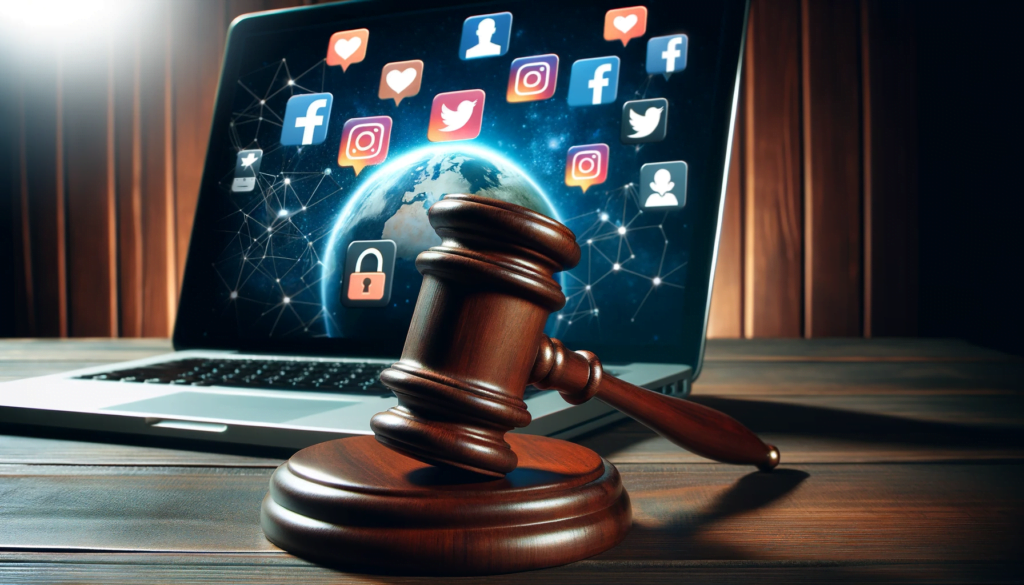
The implementation of social media privacy laws significantly affects both users and companies. These laws, designed to protect user data and ensure responsible data management by companies, bring forth a range of consequences and adaptations.
Impact on Users
- Enhanced Data Protection and Privacy
- Users benefit from increased control over their data, with laws granting them rights to access, rectify, and delete their information.
- There’s greater transparency about how their data is used, stored, and shared.
- Improved Trust and Confidence
- Strong privacy laws can enhance users’ trust in social media platforms, knowing their data is protected.
- Users feel more secure sharing information on platforms that comply with stringent privacy regulations.
- Greater Awareness of Privacy Rights
- These laws often lead to increased public awareness about digital privacy and data protection rights.
- Users become more informed and cautious about the data they share online.
- Potential Limitations in Service Usage
- Stricter privacy laws might lead some platforms to restrict certain features or services to comply with legal requirements.
- Users might face inconvenience or loss of functionality in some cases.
Impact on Companies
- Increased Compliance Costs
- Adapting to privacy laws often requires significant investment in legal, IT, and compliance infrastructure.
- Smaller companies and startups might find these costs particularly challenging.
- Operational Changes and Challenges
- Companies need to revamp their data handling processes, which can involve substantial changes in operations, technologies, and staff training.
- Global companies must navigate the complexities of complying with diverse laws in different jurisdictions.
- Potential for Legal Risks and Penalties
- Non-compliance can lead to substantial fines and legal actions, impacting the company’s financial health and reputation.
- Continuous vigilance and adaptation are necessary to stay compliant with evolving laws.
- Data-Driven Business Model Adjustments
- Companies relying heavily on user data for business insights or advertising may need to modify their business models.
- There’s a growing need to balance data-driven strategies with privacy compliance.
- Innovation in Privacy-Oriented Technologies
- Companies are incentivized to innovate in privacy-preserving technologies like enhanced encryption and data anonymization.
- This innovation can lead to new opportunities and business models centered around privacy.
- Enhanced Reputation and Competitive Advantage
- Compliance with privacy laws can improve a company’s reputation and build trust with users.
- Companies known for respecting user privacy can gain a competitive advantage in the market.
- Need for Enhanced Cybersecurity Measures
- To comply with privacy laws, companies must strengthen their cybersecurity measures to protect user data from breaches.
- This leads to a stronger overall posture against cyber threats.
- Quote from a Social Media Law Expert“The evolving landscape of social media privacy laws presents both challenges and opportunities for companies to rebuild trust and strengthen their data policies.” – John Smith, Digital Law Specialist
Challenges in Enforcement and Compliance

As the digital landscape continues to evolve, enforcing and ensuring compliance with social media privacy laws presents a set of complex and multifaceted challenges. Here’s a detailed look at these challenges:
1. Rapid Technological Advancements
- Keeping Pace with Innovation: Technology evolves at a breakneck pace, making it difficult for laws to keep up with new developments and platforms.
- Complexity of Technologies: Understanding the intricacies of advanced technologies like AI, blockchain, and IoT poses a significant challenge for regulators.
2. Globalization vs. Localization
- Jurisdictional Overlaps: With social media operating globally, determining which laws apply to multinational companies can be challenging.
- Data Localization Laws: The trend towards data localization adds complexity to compliance, as companies must navigate varying local laws.
3. Varying Standards and Regulations
- Diverse Privacy Standards: Different countries and regions have varying standards and definitions for privacy, making universal compliance difficult.
- Harmonizing Laws: Creating a cohesive approach that respects the diverse legal landscapes while ensuring effective protection is a significant challenge.
4. Enforcement Capabilities
- Resource Limitations: Many regulatory bodies lack the resources and technical expertise needed to effectively monitor and enforce privacy laws.
- Cross-border Enforcement: Coordinating enforcement actions across different jurisdictions remains a logistical and legal hurdle.
5. Corporate Compliance Challenges
- Understanding Legal Obligations: For companies, particularly SMEs, understanding and keeping abreast of all relevant privacy laws is daunting.
- Implementing Compliance Measures: Integrating comprehensive privacy measures into existing systems and practices can be costly and complex.
6. User Awareness and Behavior
- Lack of Awareness: Users often lack understanding of their rights and the privacy policies of the platforms they use.
- Behavioral Overconfidence: A false sense of security among users can lead to risky online behaviors, undermining privacy protections.
7. Legal Ambiguities and Loopholes
- Ambiguous Legislation: Vague or broad legal terms can create uncertainties in enforcement and compliance.
- Exploitation of Loopholes: Companies might find and exploit loopholes in laws to circumvent compliance.
8. Emerging Forms of Social Media
- New Platforms and Practices: As new forms of social media emerge (e.g., decentralized platforms), they bring unique privacy challenges that existing laws may not adequately address.
9. Balancing Privacy with Other Rights
- Freedom of Speech and Information: Finding a balance between protecting privacy and ensuring freedom of speech and access to information.
- Economic Interests: Balancing privacy protections with economic interests, especially in industries reliant on data.
10. Evolving Public Expectations
- Changing Attitudes: Public attitudes towards privacy are constantly evolving, requiring laws and enforcement strategies to adapt accordingly.
- Demand for Transparency: Users increasingly demand transparency and accountability from social media platforms.
Case Study: Enforcement of GDPR in the European Union
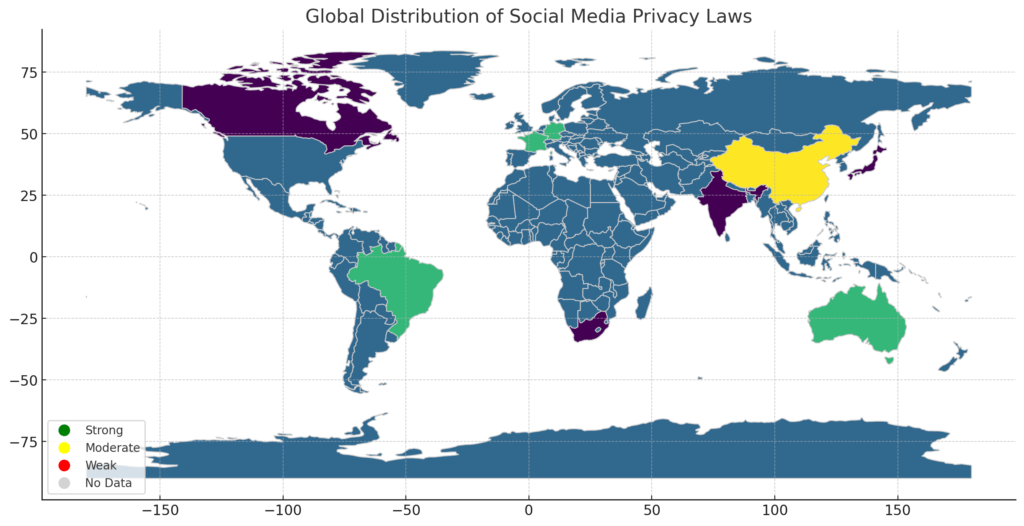
The implementation and enforcement of the General Data Protection Regulation (GDPR) in the European Union offers a comprehensive case study on the challenges, implications, and outcomes of enforcing robust privacy laws in a complex digital landscape.
Background
- Introduction of GDPR: Launched in May 2018, GDPR was introduced to harmonize data privacy laws across Europe, protect EU citizens’ data privacy, and reshape the way organizations across the region approach data privacy.
- Key Provisions: GDPR brought forth stringent rules on consent, data subject rights, data breach notifications, and hefty penalties for non-compliance.
Challenges Faced
- Compliance Complexity: Many companies, especially small and medium-sized enterprises (SMEs), found it challenging to understand and implement the necessary changes to comply with GDPR.
- Technological Adaptation: Adapting existing systems and processes to meet GDPR requirements demanded significant technological overhauls for many organizations.
- International Data Transfers: GDPR placed restrictions on data transfers outside the EU, impacting the global operations of multinational companies.
Enforcement Actions
- High-Profile Fines: Notable fines were levied against major corporations for various infringements, sending a strong message about the seriousness of GDPR compliance.
- Consistency Across EU: The European Data Protection Board (EDPB) worked towards ensuring a consistent application of GDPR across member states, addressing disparities in enforcement.
Impact and Outcomes
- Increased Data Protection Awareness: GDPR significantly raised awareness among both organizations and individuals about data privacy.
- Behavioral Changes in Organizations: Many companies revamped their data handling practices, leading to a more privacy-conscious corporate culture.
- Empowerment of Individuals: EU citizens became more empowered to exercise their data rights, leading to a higher number of data access requests and complaints.
Global Influence
- Model for Other Countries: GDPR has served as a benchmark for other countries developing or updating their data privacy legislation.
- Promotion of Global Privacy Standards: The regulation has been influential in shaping discussions about data privacy standards worldwide.
Ongoing Developments
- Evolving Case Law: GDPR enforcement and interpretation are continuously evolving, with case law providing further guidance on its application.
- Adaptation to New Technologies: GDPR is being tested and interpreted in the context of new technologies like AI and blockchain.
Lessons Learned
- Importance of Clear Guidelines: The need for clear, actionable guidance for organizations to comply with complex regulations.
- Balancing Act: The challenge of balancing the protection of individual rights with the practical realities of technological and business practices.
- Proactive Compliance Culture: The crucial role of developing a proactive compliance culture within organizations to adapt to evolving privacy norms.
The Future of Social Media Privacy Laws
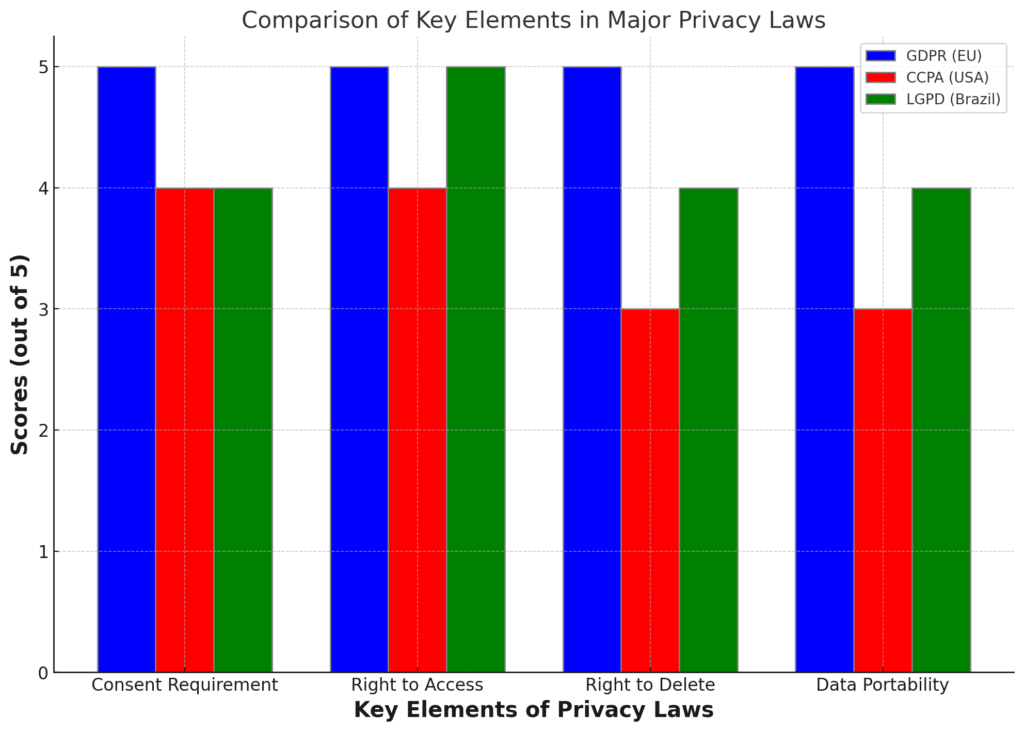
As we navigate deeper into the digital age, the future of social media privacy laws is set to undergo significant transformations. These changes are driven by evolving technologies, shifting user behaviors, and the increasing complexity of the digital ecosystem. Here’s an expanded view of what the future may hold:
Enhanced Global Standards and Cooperation
- Unified Global Frameworks: We might see efforts towards creating more unified global privacy standards, reducing the complexity of compliance for international companies.
- International Cooperation: Enhanced cooperation between countries could lead to more effective cross-border data regulation and enforcement.
Increasing Emphasis on Individual Rights
- Right to Digital Autonomy: New laws may focus on granting individuals more control over their digital footprints, including the right to be forgotten and the right to data portability.
- Consent and Transparency: Future regulations will likely demand clearer, more explicit consent for data collection and use, and full transparency from companies on data practices.
Technological Advancements and Privacy Laws
- Artificial Intelligence: As AI becomes more integral to social media, laws will need to address issues around automated decision-making, bias, and transparency.
- Blockchain for Privacy: Blockchain technology might be leveraged for its potential to offer decentralized, secure ways of managing personal data.
- Quantum Computing: With its arrival, new standards in encryption and data security will be necessary to protect against advanced threats.
Adapting to New Forms of Social Media
- Augmented and Virtual Reality: As AR and VR become mainstream in social media, privacy laws will need to tackle the unique challenges posed by these immersive technologies.
- Internet of Things (IoT): With more devices connecting to social media, laws will need to cover a broader spectrum of data collection and processing.
Data Localization and Sovereignty
- Local Data Storage: More countries may require data to be stored locally, leading to new challenges and adjustments in how social media platforms operate globally.
- Digital Sovereignty: This concept might gain more prominence, with nations seeking greater control over their digital ecosystems.
Addressing Emerging Social Challenges
- Misinformation and Online Harms: Laws may evolve to hold platforms more accountable for the content they disseminate, balancing the need for free speech with protection from online harms.
- Digital Inclusion and Accessibility: Future laws could address the need for equitable access to social media, ensuring that privacy protections are inclusive of all demographics.
Focus on Privacy Education and Advocacy
- Public Awareness Campaigns: Increased efforts in educating the public about digital privacy rights and safe social media practices.
- Advocacy for Digital Rights: Growth in advocacy groups focused on protecting digital rights and privacy in the social media landscape.
Corporate Responsibility and Ethical Practices
- Ethical Data Use: Companies might be held to higher ethical standards in how they collect, use, and share user data.
- Privacy by Design: Stronger emphasis on incorporating privacy considerations into the design and development of new technologies and platforms.
Predictive and Reactive Regulations
- Proactive Policies: Legislators may begin to create more forward-looking policies that anticipate future technological developments.
- Rapid Response Mechanisms: As technology evolves rapidly, the legal framework might adapt to include mechanisms for quicker responses to emerging privacy concerns.
Best Practices for Users and Companies
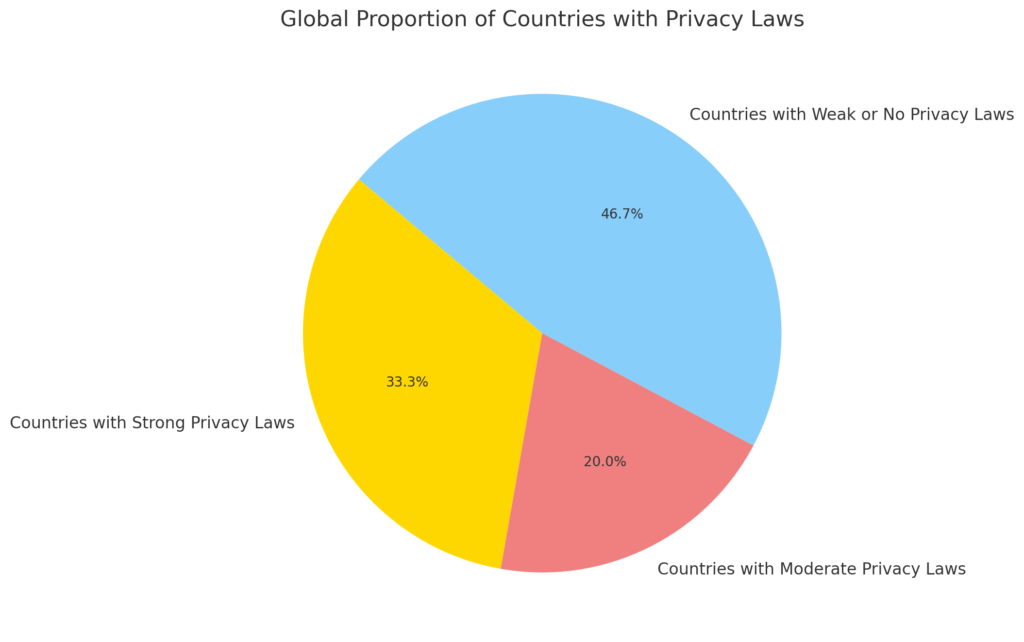
For Users
- Stay Informed About Privacy Settings:
- Regularly review and understand the privacy settings of each social media platform.
- Be aware of what information is public and what is private.
- Manage Consent and Preferences:
- Actively manage consent settings for data collection and sharing.
- Opt out of unnecessary data sharing and tracking features.
- Secure Personal Information:
- Avoid sharing sensitive personal information like addresses or phone numbers on social media.
- Use strong, unique passwords for each social media account.
- Be Cautious with Third-Party Apps:
- Scrutinize third-party apps requesting access to your social media accounts.
- Regularly review and revoke unnecessary permissions.
- Stay Updated on Data Breaches:
- Keep informed about any data breaches involving social media platforms.
- Take immediate action if your data is compromised (e.g., change passwords, or monitor accounts).
For Companies
- Adopt a Privacy-First Approach:
- Prioritize user privacy in all aspects of business operations and product development.
- Implement privacy by design principles to integrate privacy into your technology, network infrastructure, and business practices.
- Ensure Compliance with Global Laws:
- Stay informed about evolving global privacy laws and ensure compliance.
- Conduct regular audits to assess and improve privacy measures.
- Transparent Data Practices:
- Communicate with users about how their data is collected, used, and shared.
- Develop clear, user-friendly privacy policies and consent forms.
- Data Security Measures:
- Implement robust security protocols to protect user data.
- Regularly update and test security systems to prevent breaches.
- User Data Rights:
- Facilitate easy access for users to view, edit, or delete their data.
- Respect users’ requests for data deletion and handle such requests promptly.
- Employee Training and Awareness:
- Train employees on the importance of data privacy and security.
- Create a culture of privacy awareness within the organization.
- Engage in Responsible Data Processing:
- Limit data collection to what is necessary and relevant.
- Avoid excessive data retention and securely dispose of data that is no longer needed.
- Respond Effectively to Data Breaches:
- Have a response plan in place for potential data breaches.
- Notify affected users promptly and take immediate action to mitigate any harm.
Conclusion
In conclusion, the comparative analysis of global social media privacy laws reveals a diverse and evolving landscape. Understanding these differences is crucial for both users and companies in navigating the digital world safely and responsibly. As technology continues to advance, staying informed and proactive in privacy matters is more important than ever.
FAQ
How do GDPR and CCPA differ in their approach to privacy?
GDPR is more comprehensive in user rights and consent, while CCPA focuses on transparency and consumer control over personal information.
Can a company be compliant with one country’s privacy law but not another’s?
Yes, due to the differing requirements and scopes of various national laws, a company might comply with one but not another.
What impact do social media privacy laws have on businesses?
These laws require businesses to implement stringent data protection measures, affecting how they collect, store, and process user data.
Are social media platforms required to comply with privacy laws in countries where they don’t operate?
It depends on the law. Some, like the GDPR, have extraterritorial scope, meaning they apply to any company processing EU citizens’ data, regardless of location.
How do privacy laws protect against data breaches?
They mandate robust security measures and protocols to prevent unauthorized access to personal data.
What rights do users have under these privacy laws?
Rights typically include access to their data, corrections, deletions, and objections to certain types of processing.
How often do privacy laws get updated?
It varies by region, but generally, laws are reviewed and updated in response to new technological developments and challenges.
Can users take legal action if their privacy rights are violated?
Yes, most privacy laws provide mechanisms for users to file complaints and seek legal recourse.
What future trends are expected in social media privacy laws?
Increased regulations, especially in areas like AI and IoT, and possibly more uniformity in laws across countries.






![Social Media Optimization [2024 Exquisite Guide] 26 Infographic detailing the differences and synergies between SEO and SMO.](https://www.knowskit.com/wp-content/uploads/2024/01/comparing-seo-and-smo-in-digital-marketing-768x439.png)
